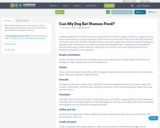
Most of the food that we eat is also safe for our four legged friends, but there are some food items that are very harmful and unhealthy for them.
- Subject:
- Social Science
- Social Work
- Material Type:
- Homework/Assignment
- Date Added:
- 06/04/2019

Most of the food that we eat is also safe for our four legged friends, but there are some food items that are very harmful and unhealthy for them.
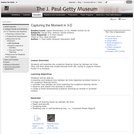
Students will examine the sculpture "Rearing Horse" by Adriaen de Vries. They will then draw and sculpt animals from life, trying to capture motion frozen in a moment.
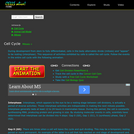
During development from stem to fully differentiated, cells in the body alternately divide (mitosis) and "appear" to be resting (interphase). This sequence of activities exhibited by cells is called the cell cycle. Watch this animation to learn more about each of the stages in the cell cycle: interphase, gap 0, gap 1, S Phase, gap 2, and M phase.
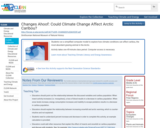
Students run a simplified computer model to explore how climate conditions can affect caribou, the most abundant grazing animal in the Arctic.

Students explore the importance and process of classification. Students apply the concept of biological classification to a real hierarchy of birds, analyzing bird photos and organizing them into groups based on physical characteristics.
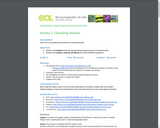
Students use EOL Species Cards to sort and make observations of animals, then use the RAFT writing strategy to create short presentations about the characteristics of each major group of animals.
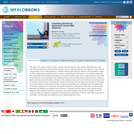
The topic of this video module is how to classify animals based on how closely related they are. The main learning objective is that students will learn how to make phylogenetic trees based on both physical characteristics and on DNA sequence. Students will also learn why the objective and quantitative nature of DNA sequencing is preferable when it come to classifying animals based on how closely related they are. Knowledge prerequisites to this lesson include that students have some understanding of what DNA is and that they have a familiarity with the base-pairing rules and with writing a DNA sequence.

Students investigate decomposers and the role of decomposers in maintaining the flow of nutrients in an environment. Students also learn how engineers use decomposers to help clean up wastes in a process known as bioremediation. This lesson concludes a series of six lessons in which students use their growing understanding of various environments and the engineering design process, to design and create their own model biodome ecosystems.

Students learn how turtle populations may be affected by climate change and develop solutions to this potential problem.
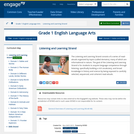
The goal of the Listening and Learning Strand is for students to acquire language competence through listening, specifically building a rich vocabulary, and broad knowledge in history and science by being exposed to carefully selected, sequenced, and coherent read-alouds. The 9 units (or domains) provide lessons (including images and texts), as well as instructional objectives, core vocabulary, and assessment materials. The domain topics include: Different Lands, Similar Stories; Fables and Stories; The Human Body; Early World Civilizations; Early American Civilizations; Astronomy; Animals & Habitats; Fairy Tales; and History of the Earth.
Find the rest of the EngageNY ELA resources at https://archive.org/details/engageny-ela-archive .
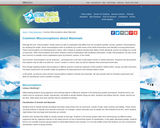
This article lists common misconceptions about mammals. It provides formative assessment probes and information about teaching for conceptual change.
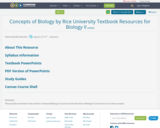
This includes materials to be used for a General Biology II course (or Introduction to Biology II course) for non-science majors.
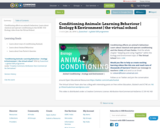
Conditioning affects an animal's behaviour. Learn about classical and operant conditioning in this GCSE / K12 Ecology video from the Virtual School.
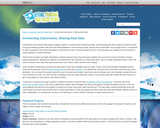
This article describes six collaborative and real data projects that engage elementary students in collecting and sharing local data and communicating with students across the country and world.
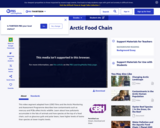
The levels of contaminants found in particular animals vary widely depending on where they fit into the Arctic food chain, as described in this video segment adapted from LOKE Films and the Arctic Monitoring and Assessment Programme.

The author explains heat transfer and how it applies to living in extremely cold environments.
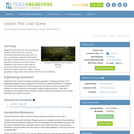
In this lesson, students find their location on a map using Latitude and Longitudinal coordinates. They determine where they should go to be rescued and how best to get there.
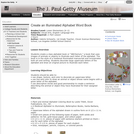
Students create a class alphabet book or "ABCDarium," a book that uses images of animals or objects to illustrate each letter of the alphabet. The book is in the style of a medieval illuminated manuscript and incorporates both art and writing. Students decorate large uppercase letters of the alphabet and draw an original picture to illustrate each letter.
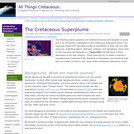
The following topical questions and selected resources are designed to guide you in an introductory exploration of the Cretaceous superplume event. The resources linked from this page include an assortment of web- and non-web resources, published papers, abstracts, graphics, and animations. Direct links to web resources are followed by a "more info" link that gives a short description of the web resource. These resources by no means comprise a comprehensive treatment of the literature on the subject, but should at least give you a place to start in your study of the Cretaceous superplume event.
(Note: this resource was added to OER Commons as part of a batch upload of over 2,200 records. If you notice an issue with the quality of the metadata, please let us know by using the 'report' button and we will flag it for consideration.)
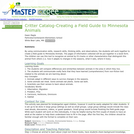
This activity will help students learn about Minnesota animals and characteristics that distinguish them from one another.